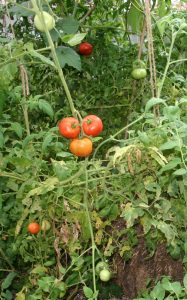Have you ever heard about straw-bale gardening and wondered what it entails? The answer is more than just stacking straw bales to make windbreaks or taking them apart and using the straw for mulch. Straw bales are far more versatile. They can be used as a base for growing plants in a greenhouse. But when buying straw bales, make sure that the farmer who grew the straw didn’t use long-lasting pesticides on his plants. If you neglect this important precaution, pesticide residues can find their way into your garden soil and consequently damage the garden’s ecosystem.
When used straw bales in my greenhouse in Rhode Island, I started the process in March by moving two bales into the greenhouse, standing them wit the string sides vertical and watering the heck out of them. When adequately watered, straw bales slowly heat up. This provides heat to plants that are rooted in or on them. What’s more, heat emanating from the straw warms the air, which is helpful in a greenhouse in March when frosts still sneak up at night.
The first step is soak the straw thoroughly and fortify it with nutrients because straw alone won’t feed your plants. I added two cups of nitrogen-rich blood meal, one cup of calcium-rich bone meal, and one cup of triple phosphate to the top of each bale (the top is now the sides where the straw sticks out. The string on each bale is wrapped around the sides. This gives better water and nutrient penetration.) I then soaked each bale with three to five gallons of water. This water provided much-needed moisture to the dry straw; it also washed the added nutrients into the straw. Each day thereafter I added another three or four gallons of water, to keep the bales saturated and help them begin to decompose and heat up..

Every two or three days I checked each bale’s temperature. By the fourth day, the bales’ internal temperatures had reached 100o F. In a week, the readings had climbed to between 120 and 130o, at which point I added another cup of blood meal to keep the heating going. I then dug three holes 6-8 inches in diameter across each bale, into which I put a mixture of potting soil (Promix BX) and compost. A week later (by then the first week of April), I set a small tomato plant in each hole and watered them in well.
These plants took off and, with continued watering, they grew at a very rapid rate. Control plants in nearby soil did not grow as fast or set fruit as early. I was able to pick my first straw-bale tomato on June 4th. By the middle of July, these plants were eight feet tall and approaching the greenhouse roof. Because they were indeterminate-type tomato plants, they kept producing fruit until late November, at which point they were about four to six feet wide, so wide that several tomatoes in the middle were difficult to reach. As an added bonus at the end of the growing season, I spread the partially decomposed straw over my outdoor garden as mulch.
Clearly, tomatoes are a great choice for growing things in straw bales. But it would seem that this method would work well for any plant that thrives in warmth, such as peppers, eggplants, and summer squashes. Other good candidates may be plants that require a long growing season, such as leeks, onions, and garlic. All it takes to find out is a little experimentation with this often-overlooked form of greenhouse gardening.










